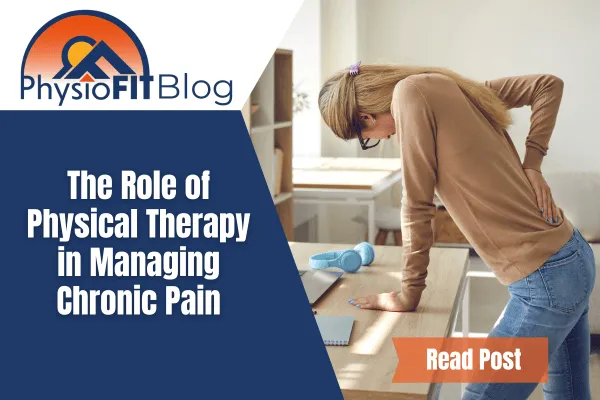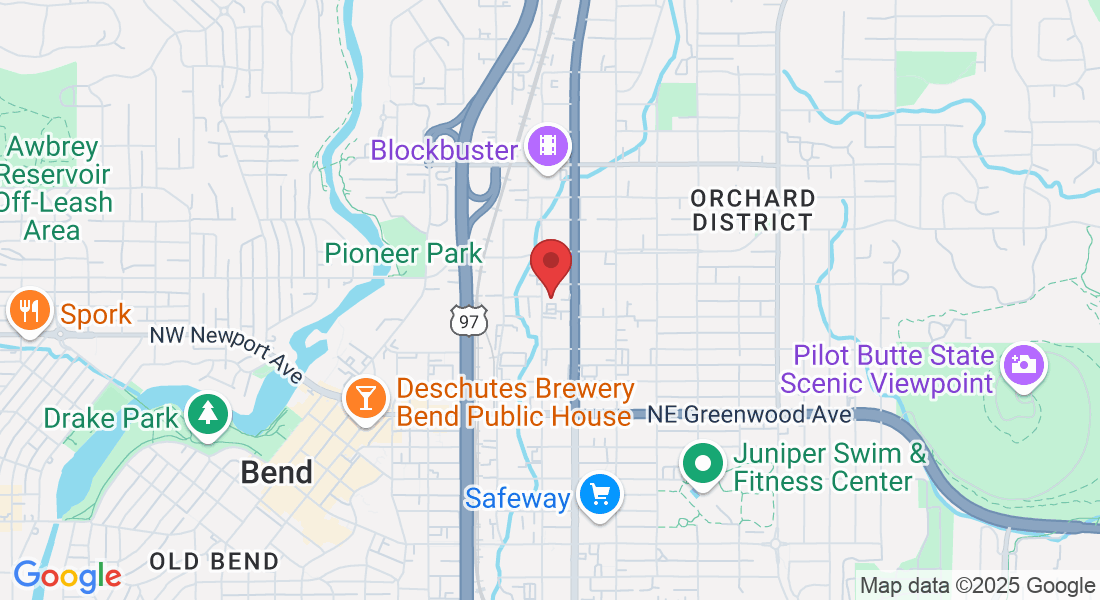Your Source for All Things Physical Therapy in Bend Oregon
The PhysioBLOG
Here, we share informative articles and insights that aim to help you achieve your full potential through our fitness-focused approach to rehabilitation. Our team is dedicated to providing you with valuable tips and techniques that can help you overcome any obstacle, whether you're recovering from an injury, surgery, or striving to build strength and wellness for life.
Stay up-to-date with our latest posts & empower yourself with elegantly simple techniques for optimal health & wellness.

The Role of Physical Therapy in Managing Chronic Pain
Please Note: The information provided on our website is intended for general education and is not a substitute for professional medical advice. Each individual's situation and body are different. Therefore, what may work for one person may not work for another. We care about your well-being and advise you to reach out to us to discuss your specific needs before implementing any advice from our website.
Key Takeaways:
Physical therapy plays a crucial role in managing chronic pain by providing non-invasive and drug-free treatment options.
Physical therapy helps in improving functional abilities, reducing pain, and restoring mobility, allowing individuals to perform daily activities with greater ease and comfort.
Incorporating physical therapy into chronic pain management involves personalized treatment plans, including exercises, manual therapy, and education, tailored to the individual's specific needs and goals.
Understanding Chronic Pain
Chronic pain is a multifaceted condition that demands comprehensive understanding for effective management. This complex phenomenon requires a deep comprehension due to its wide-ranging impact on an individuals' physical, emotional, and social well-being. Exploring the intricacies of chronic pain can unravel the key aspects underlying its management, guiding healthcare professionals towards providing the most appropriate interventions.
To fully comprehend chronic pain, it’s important to acknowledge the intricate interplay between the physiological and psychological aspects of this condition. By understanding and addressing the underlying mechanisms contributing to chronic pain, such as peripheral and central sensitization, healthcare providers can tailor treatment approaches accordingly. Additionally, recognizing the psychosocial factors that can aggrevate pain, such as stress, anxiety, and depression, enables a holistic approach that considers the patient's overall well-being.
Pain management strategies for chronic pain encompass a multidisciplinary approach, acknowledging the diverse array of factors that contribute to its development and persistence. Physical therapy plays a vital role in this multidimensional approach, utilizing various techniques to address pain, improve function, and enhance quality of life. Through exercises, manual therapy, and other interventions, physical therapists empower individuals to regain control over their pain and optimize their physical capabilities.
Moreover, lifestyle modifications and self-care practices constitute essential components of chronic pain management. By adopting healthy habits, such as regular physical activity, balanced nutrition, and adequate sleep, individuals can optimize their overall well-being and contribute to the reduction of chronic pain symptoms.
Remarkably, chronic pain affects approximately 20% of adults worldwide, highlighting its significant prevalence and impact on individuals' lives. Through a comprehensive understanding of the multifaceted nature of chronic pain, healthcare professionals can employ personalized interventions that address the underlying factors contributing to this condition. By integrating physical therapy alongside other evidence-based approaches, individuals afflicted by chronic pain can experience improved function and an enhanced quality of life.
Causes and Impact of Chronic Pain
Chronic pain, a pervasive challenge affecting numerous individuals, arises from a variety of causes, resulting in significant physical, emotional, and psychological consequences. Understanding the underlying factors and the profound impact on individuals' quality of life is crucial in developing effective strategies to manage chronic pain.
Physical therapy plays a pivotal role in addressing the causes and mitigating the negative consequences of chronic pain. Through targeted interventions, physical therapy aims to reduce pain, enhance physical function, improve mobility, and promote overall well-being. By utilizing a variety of techniques, including exercise, manual therapy, and education, physical therapists help individuals manage their pain and regain control over their lives, enabling them to engage in daily activities with greater ease and comfort.
The Role of Physical Therapy in Managing Chronic Pain
Physical therapy plays a crucial role in effectively managing chronic pain. It utilizes various techniques and interventions to address the underlying causes of pain, improve mobility, and enhance overall quality of life. By incorporating exercises, manual therapy, and other modalities, physical therapy aims to reduce pain, restore function, and promote long-term pain management. Moreover, skilled physical therapists tailor treatment plans to the specific needs of each individual, considering factors such as the type and location of pain, medical history, and personal goals. By empowering patients with knowledge and self-management strategies, physical therapy serves as an important component of a comprehensive approach to managing chronic pain.
A Pro Tip: It is beneficial for individuals with chronic pain to seek early physical therapy intervention for better pain management outcomes.
Tips and Strategies for Incorporating Physical Therapy into Chronic Pain Management
Physical therapy plays a crucial role in managing chronic pain by offering various effective techniques and approaches. By incorporating physical therapy into chronic pain management, individuals can experience relief and improved quality of life. Here are three key tips and strategies for integrating physical therapy into chronic pain management:
Tailored Exercise Programs: Physical therapists develop personalized exercise programs that target specific areas of pain and strengthen the body. These exercises help to improve flexibility, mobility, and overall physical function, thus reducing pain levels.
Manual Therapy Techniques: Physical therapists use hands-on techniques like massage, joint mobilization, and manipulation to reduce pain and improve joint and muscle function. These manual therapy techniques can help alleviate pain, enhance flexibility, and promote healing.
Education and Self-management: Physical therapists provide extensive education and teach self-management strategies to individuals with chronic pain. This includes teaching proper body mechanics, ergonomics, and postural awareness to prevent pain exacerbation. They also educate patients about pain management techniques like relaxation exercises and stress reduction.
By incorporating these tips and strategies for physical therapy into chronic pain management, individuals can effectively reduce pain, improve function, and enhance their overall well-being. Remember, it is always essential to consult with one of our physical therapists to assess an individual's specific needs and develop an appropriate treatment plan tailored to their condition. So contact us today for an appointment at PhysioFITBend.com.
A unique aspect of physical therapy in chronic pain management is the focus on addressing the root cause of pain rather than solely relying on medication. Physical therapists work closely with patients to identify triggers, address underlying issues, and develop comprehensive treatment plans that integrate various techniques for long-term pain relief.
In a true history related to physical therapy and chronic pain management, physical therapists have been successfully helping individuals manage chronic pain through evidence-based practices for decades. With ongoing advancements in treatment approaches and a greater understanding of pain management, physical therapy continues to play a significant role in improving the lives of individuals with chronic pain.
Some Facts About Physical Therapy in Managing Chronic Pain:
✅ Chronic pain affects approximately 116 million Americans each year.
✅ The annual cost of chronic pain in the United States is estimated to be $560–$635 billion.
✅ Chronic pain can occur independently of any actual body tissue damage and beyond normal healing time.
✅ Physical therapists work with chronic pain patients to reduce pain and restore activity levels.
✅ Chronic pain can lead to decreased activity levels, job loss, anxiety, depression, and disability.
FAQ
What is chronic pain and how is it different from acute pain?
Chronic pain is any discomfort or unpleasant sensation that lasts for more than three months, beyond the expected normal healing time. This pain may persist even when there is no new tissue damage. In contrast, acute pain is a short-term sensation that acts as a warning signal for possible injury or tissue damage.
How does the brain contribute to chronic pain?
In chronic pain, the brain and nervous system become more sensitive and go on "high alert." They interpret sensations as a threat, even when there is no ongoing tissue damage. This process increases pain sensations and can be triggered by any sensory input, including thinking about pain or reading the word pain.
What medical conditions are more likely to cause chronic pain?
Some medical conditions that are more likely to cause chronic pain include trauma/injury, diabetes mellitus, fibromyalgia, limb amputation, and reflex sympathetic dystrophy. Additionally, diseases like cancer and arthritis can also cause ongoing pain.
How does chronic pain affect individuals?
Chronic pain affects each person differently. It can lead to decreased activity levels, job loss, financial difficulties, as well as anxiety, depression, and disability. The adverse effects of chronic pain can be significant and impact a person's overall well-being.
How can physical therapy help manage chronic pain?
Physical therapists work together with chronic pain patients to lessen their pain and restore their activity to the highest possible levels. Through various therapeutic techniques, exercises, and interventions, physical therapy aims to reduce pain, improve mobility, enhance function, and optimize overall quality of life.
What are some safe alternatives to opioids for long-term pain management?
The American Physical Therapy Association promotes physical therapy as a safe alternative to opioids for long-term pain management. Physical therapy utilizes non-pharmacological approaches such as exercise, manual therapy, modalities, and education to effectively manage chronic pain without the risks and side effects associated with opioid use.
Please Note: It's important to note that any exercises or techniques that are shared should be performed under the guidance of a qualified physical therapist in bend to ensure correct technique and to prevent injuries. A physical therapist can provide a customized exercise program based on the individual's fitness level, goals, and any existing injuries or conditions. If you’d like to explore this more or would like to schedule a time with a physical therapist in Bend Oregon, contact us atPhysioFITBend.com
Ask The Experts

PT, MSPT, OCS, CF-L1

PT, DPT, TPI, CF-L1

PT, DPT, CSCS
Copyright PhysioFIT 2025 . All Rights Reserved


